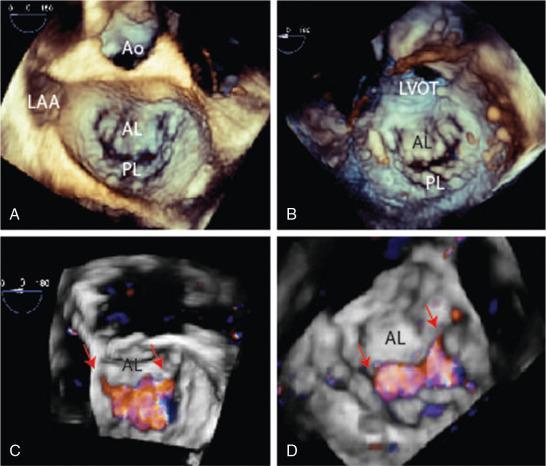Physical Address
304 North Cardinal St.
Dorchester Center, MA 02124
The field of structural heart disease interventions is expanding rapidly. Advances in cardiac imaging are playing a central role in patient selection, imaging guidance, and follow-up of patients undergoing transcatheter mitral valve procedures (TCMVPs).
Three-dimensional transesophageal echocardiography has become the fundamental technique for imaging guidance of TCMVP.
Advances in heart and mitral valve modeling and echocardiographic-fluoroscopic (echo/fluoro) fusion imaging have enhanced the applicability of cardiac ultrasound in the cardiac catheterization laboratory and the hybrid operating room.
There is significant interest in determining the role of cardiac magnetic resonance imaging in quantifying mitral regurgitation severity in patients after transcatheter mitral valve clip implantation, for which echocardiography may be imprecise.
Multislice computed tomography provides high-resolution reconstructions of the mitral annulus and plays an important role in the nascent area of percutaneous mitral valve replacement.
Mitral regurgitation (MR), the most common form of valvular heart disease, can result from disease of the mitral valve (MV) apparatus (i.e., primary MR) or from disease of the left ventricle (i.e., secondary MR). Mitral stenosis (MS), the least common form of valvular heart disease, can be related to rheumatic fever (i.e., rheumatic MS) or to calcific degenerative changes of the MV (i.e., calcific MS). Severe symptomatic MV disease has traditionally been treated surgically through MV repair or replacement. In great part due to advances in cardiac imaging, transcatheter treatment of MV disease has become an alternative to surgery for patients with severe MV disease.
Five major domains of transcatheter mitral valve procedures (TCMVPs) have emerged: (1) balloon-induced commissurotomy for rheumatic MS, (2) edge-to-edge repair with placement of one or more mechanical clips to enhance leaflet coaptation and induce annular modification for MR, (3) annular reduction by direct or indirect techniques for MR, (4) plugging of paraprosthetic leaks causing MR, and (5) insertion of bioprosthetic valves for MR and MS disease of the native MV or a degenerated bioprosthetic valve. Some therapies are well established with extensive insights into imaging guidance issues, and others are emerging technologies with experience limited to early feasibility studies. The imaging guidance considerations for each of these five domains are discussed in the following sections.
Imaging guidance plays a central role in the successful and safe execution of all TCMVPs. New interventions have stimulated improvements in imaging guidance technologies and techniques, and advances in imaging guidance technologies and experience have enabled the development of new interventional therapies. This push-pull relationship between medical imaging and devices is a key aspect for the future of this field.
Imaging guidance for the five domains of TCMVPs and for preprocedural planning has several common goals that provide an organizing principle for what can otherwise be diverse tasks that must be performed for different types of interventions. These include the following:
Preprocedural, intraprocedural, and postprocedural assessment of the structure and function of the MV
Planning and execution of the initial access to the left heart and MV, mainly with transseptal or transapical access
Planning and execution of delivery system placement
Planning and execution of therapeutic device deployment that involves sizing the device, targeting to a specific final location of the device, and aligning the device to key structures
Prediction, detection, and actions in response to potential complications
These imaging-related goals of TCMVPs are addressed by an expanding array of imaging modalities with specialized applications that provide optimal visualization for performance of specific tasks, quantitation of key variables, and the ability to combine different modalities to enhance workflow efficiency, hand-eye coordination, and understanding of complex three-dimensional (3D) relationships.
Fluoroscopy, angiography, and hemodynamic assessment have been the main guiding tools in the catheterization laboratory, but as the field of structural heart disease interventions has developed, advanced cardiac imaging techniques, including echocardiography, cardiac magnetic resonance imaging (CMR), and computed tomography (CT) have complemented cine-angiography by providing soft tissue characterization not available with the radiographic techniques alone. , Noninvasive imaging guidance techniques provide superb visualization of the cardiac structures from perspectives previously seen only by the surgeon in the beating heart. Noninvasive imaging modalities, specifically echocardiography, have become the foundation for patient selection, imaging guidance, and evaluation of results in patients undergoing all structural heart disease interventions but especially MV interventions.
Imaging guidance and preprocedural planning required new skill sets and a new focus in the careers of those who partner with catheter interventionalists. Several publications have reviewed transcatheter valve technology for the treatment of valvular heart disease , and have highlighted the central role played by cardiac imaging and imaging experts in achieving a successful intervention. The development of dedicated heart teams, composed of cardiac surgeons, interventionalists, anesthesiologists, and cardiac imagers, for the contemporary management of advanced valvular heart disease solidifies the importance of imaging in structural heart disease interventions. ,
In response to these new therapeutic options for treating MV disease and the central role of imaging for planning and guiding interventions, professional societies have needed to expand training, other educational efforts, and facility requirements as experience and best practices have evolved. The 2014 American Heart Association (AHA)/American College of Cardiology (ACC) guidelines for the management of patients with valvular heart disease support the use of TCMVP for symptomatic patients with severe MS and for severely symptomatic patients with chronic severe primary MR who have a prohibitive surgical risk because of severe comorbidities.
The European Association of Echocardiography (ESE), in partnership with the American Society of Echocardiography (ASE), published recommendations for the use of transcatheter interventions for valvular heart disease. , These updated the previous recommendations of the ASE on echocardiographic-guided interventions. The expert consensus document of the Society for Cardiovascular Angiography and Interventions (SCAI), American Association for Thoracic Surgery (AATS), ACC, and Society for Thoracic Surgeons (STS) on the operator and institutional requirements for transcatheter valve repair and replacement highlighted the importance of noninvasive imaging, requiring that institutions engaged in TCMVP have adequate noninvasive imaging facilities.
This chapter reviews the critical role played by cardiac imaging in TCMVP. It highlights TCMVP general imaging guidance issues, common and advanced imaging tools in use, and imaging guidance of specific TCMVPs and presents our view of the future of this field.
Imaging guidance of TCMVPs requires detailed knowledge of MV anatomy and pathology, a clear understanding of the available interventional procedures used in MV interventions, and experience with the standard and advanced imaging techniques used to guide TCMVPs. Table 21.1 summarizes the fundamental imaging guidance principles related to TCMVPs. Thoughtful imaging guidance planning enhances the chance of a successful intervention.
| Assessment of Mitral Anatomy and Function | Understanding of Catheters, Devices, and Access Pathways | Planning of Imaging Guidance |
|---|---|---|
| Preprocedural Planning | ||
|
What type and size of device are needed? | What imaging modalities will be necessary? |
|
Femoral vein access , inferior vena cava, plane of interatrial septum, trajectory to align with mitral valve | Assess what imaging guidance challenges and limitations may exist for individual patients. |
|
Choose the interatrial septum puncture site. | Determine which gantry locations will be needed to perform certain tasks. |
|
Arterial access , retrograde aortic pathway, trajectory to mitral valve targets | Is the procedure likely to carry a high radiation dose, and what steps can be taken to minimize this? |
|
Transapical access , left ventricular entry point, trajectory to mitral valve targets | Will contrast use be limited by renal dysfunction? |
| Intraprocedural Guidance | ||
|
Define key sequential steps in performing the mitral valve intervention. | Clear and precise communication with interventionalist |
|
Guide intervention with a complication prevention frame of mind. | Anticipate imaging guidance needs for the interventionalist. |
|
Recognize common and uncommon device-induced artifacts. | Suggest alternative imaging tool if the one being used proves inadequate. |
| Postprocedural Assessment | ||
|
Identify when adjustments or additional intervention should be made. | Detect and understand intraprocedural complications and how serious they are. |
Preprocedural planning requires precise characterization and assessment of MV morphology and function and of how the native or prosthetic MV will be affected by the intervention. Familiarity with catheters, devices, and interventional workflow is mandatory. Appropriate imaging guidance of TCMVP also requires detailed knowledge of the access pathways used to reach the interventional target. Choosing the appropriate imaging tools for preprocedural planning depends on the planned intervention and the advantages and disadvantages of each imaging modality for the specific TCMVP.
Intraprocedural guidance means determining the imaging modalities needed to perform each step of the intervention; defining key sequential steps in performing the MV intervention; developing a common language to facilitate communication between imager and interventionalist; familiarity with catheters, devices, and interventional workflow; recognizing specific imaging limitations; and considering available alternatives.
Anticipation of imaging guidance needs for the interventionalist is essential. Intraprocedural detection and understanding of complications is often first informed by imaging, and the imaging specialist must be familiar with potential complications such as thrombus on catheters, guidewires, and devices; pericardial effusion and tamponade; and embolization of equipment. At the completion of the intervention but before the patient leaves the procedure room, imaging is often combined with traditional catheter-based hemodynamics to assess the success of the intervention and identify when adjustments need to be made.
Postprocedural assessment is directed to the final assessment of the intervention, often after the patient has awakened and returned to a baseline hemodynamic state.
Matching of the optimal imaging modality with advanced tools for optimal visualization is central to the planning, execution, and evaluation of TCMVPs. Fig. 21.1 outlines the standard and advanced imaging tools used for the preprocedural, intraprocedural, and postprocedural stages of TCMVPs. The main applications and the advantages and disadvantages of each imaging modality are highlighted in Table 21.2 .

| Modality | Main Application | Advantages | Disadvantages |
|---|---|---|---|
| Standard Imaging Tools | |||
| X-ray imaging | Intraprocedural guidance | Standard equipment in catheter laboratory Best visualization of catheters and devices |
Radiation exposure Need for contrast No soft tissue visualization |
| 2D and 3D TEE , , | Preprocedural planning Intraprocedural guidance Postprocedural assessment |
Soft tissue visualization Provides real-time/multibeat anatomic and physiologic data |
TEE is semi-invasive. Need for intubation Variability of image quality and imaging artifacts Operator dependence |
| Intracardiac echocardiography | Intraprocedural guidance | No need for anesthesia and intubation | Added cost, small field of view, lacks 3D imaging |
| Magnetic resonance imaging , | Preprocedural planning Potential intraprocedural guidance Postprocedural assessment |
No radiation Outstanding spatial resolution Gold standard for left ventricular volumes Noninvasive |
Impractical for intraprocedural guidance Cardiac cycle dependence |
| CT | Preprocedural planning | Comprehensive cardiac and vascular assessment Outstanding spatial resolution High reproducibility Calcium is well seen and characterized Noninvasive |
Contrast required Radiation exposure Cardiac cycle dependence Poor temporal resolution |
| Advanced Imaging Tools | |||
| Echocardiographic-fluoroscopic fusion , | Intraprocedural guidance | Real-time overlay of catheters and devices (fluoroscopy) on cardiac anatomic structures (3D TEE) | Few studies have documented its value. |
| Overlay of 3D CT and fluoroscopy | Intraprocedural guidance | Overlay of catheters and devices (fluoroscopy) on frozen cardiac anatomic structures (CT) | CT not in real time |
| Mitral valve 3D modeling , | Preprocedural planning Evaluation of results |
Realistic model of mitral annulus | Few studies have documented its value. |
| Rapid prototyping | Preprocedural planning | Actual physical model with which devices can be tried | Few studies have documented its value. |
Fluoroscopy and, to a lesser degree, angiography are the basic imaging guidance tools for the performance of TCMVPs. These imaging tools are part of the standard cardiac catheterization laboratory and are routinely used for most parts of the intervention: aiding in vascular access; guiding vascular and cardiac navigation of guidewires, catheters, and devices; and positioning and deploying devices on the structural targets ( Fig. 21.2 ).

Because the x-ray field of view is large, encompassing the whole chest, it provides a comprehensive imaging perspective of the cardiovascular areas of interest. The main disadvantage of x-ray techniques for procedural guidance is the lack of detailed characterization of the soft tissues structures in the heart.
Fluoroscopy consists of projection of images of radiopaque structures that are flat or two-dimensional (2D) images with loss of depth. Only by changing the perspective can the clinician start to understand depth and 3D relationships. Another disadvantage of cine-fluoroscopy is radiation exposure and the use of potentially nephrotoxic and intravascular volume-expanding contrast agents.
Ventriculography can be used in the preprocedural and postprocedural evaluation of ventricular volumes and for evaluation of the severity of MR. Digital laboratories provide rapid, accurate measurements of left ventricular (LV) volume that have been validated with human heart casts and CMR. End-systolic and end-diastolic volumes predict outcomes in regurgitant valvular lesions and should be routinely obtained when left ventriculography is performed. The radiation dose and contrast volume needed for repetitive ventriculograms reduce the usefulness of this imaging modality, especially for patients who have renal insufficiency or are already in a volume overload state.
Echocardiography has become an indispensable tool for the imaging guidance of structural heart disease interventions. Transthoracic echocardiography (TTE) is usually sufficient to provide preprocedural characterization of MV morphology and function, and it aids immensely in patient selection for MV interventions. Because of the interference with fluoroscopy, the relatively limited acoustic windows, the inability to characterize details of the MV apparatus, the additional radiation exposure to the sonographer, and the use of nonsterile probes, the value of TTE for procedural imaging guidance is limited. TTE is the usual imaging modality for long-term follow-up after MV interventions.
Transesophageal echocardiography (TEE) has become the standard imaging guidance tool for TCMVP; both 2D and 3D techniques are employed ( Fig. 21.3 ). Color Doppler images of the mitral apparatus made with 2D TEE provide high resolution and high frame rates with well-standardized imaging views. 3D TEE provides unique anatomic detail of the MV and surrounding structures and greatly facilitates guidance of catheters and devices to the area of interest. Although 3D TEE color Doppler has been somewhat limited because of slow frame rates, this technology is rapidly improving and holds promise for enhanced imaging guidance for TCMVPs ( Fig. 21.4 ).


The main strengths of echocardiographic methods for imaging guidance of TCMVP reside in their ability to provide real-time, continuous anatomic and physiologic data. The main limitation is the relatively small area of the heart that can be visualized at any given moment (compared with fluoroscopy, CT, or CMR). Quantification of MR severity after MV interventions, particularly after MitraClip deployment, is difficult, although quantification of the vena contracta area with 3D TEE shows some promise. ,
The quality of the echocardiographic images is patient dependent, and patient cooperation is unpredictable. Although the clinician can usually obtain diagnostic information, some fine anatomic details may be difficult to characterize in some patients. Imaging artifacts and drop-out also may be produced by calcified structures, catheters, prosthetic valves, and implanted devices. This highlights the importance of changing the position of the TEE probe (within the constraints of the esophagus and stomach), which may be needed for optimal visualization. Another shortcoming of echocardiography is that the image quality is operator dependent, and there is a significant learning curve.
Intracardiac echocardiography (ICE) is increasingly used to guide percutaneous interventional procedures, principally to support electrophysiologic interventions and for closure of a patent foramen ovale and small atrial septal defects (ASDs). Imaging with ICE has evolved from cross-sectional imaging using a rotating transducer (similar to intravascular ultrasound) to sector-based imaging using a phased-array transducer. Phased-array ICE is the most common form of ICE used for TCMVPs because of its high-frequency range, large depth of field, steerability, and the possibility of acquiring Doppler and color-flow imaging.
3D ICE is likely to play a significant role in the imaging guidance of TCMVPs. Reports suggest that ICE may be used for primary guidance or as a supplement to TEE for patients undergoing percutaneous MV repair and paravalvular leak (PVL) closure.
The main advantages of ICE compared with TEE are that ICE eliminates the need for general anesthesia, provides very clear images (because it can be close to the target with no air to degrade image quality), and can result in shorter procedure times, potentially reducing hospital stay and radiation doses. The main disadvantage is the additional cost of the catheter, even with resterilization and reuse. Operator skills must be developed, and the perspective of the image is limited by where the catheter can or cannot be located.
ICE can provide essential imaging guidance and procedural monitoring during percutaneous balloon mitral commisurotomy (BMC). Although currently TEE is used more frequently for imaging guidance of BMC, ICE is a viable alternative. The use of ICE for imaging guidance of periprosthetic MR has been described, suggesting that ICE could become a second-line alternative to TEE.
The MitraClip procedure is usually performed under TEE guidance. However, in some patients, TEE may not provide adequate imaging information, and the use of ICE from the left atrium (LA), both atria, or the LV for visualization and guidance of the MitraClip procedure has been described. , , MV repair with the MitraClip system assisted by ICE has been demonstrated to be feasible in patients with prior surgical rings, achieving an excellent risk profile and satisfactory procedural success. In patients with postsurgical anatomy, clear TEE imaging of the MV leaflets may be complicated by shadowing from the surgical annuloplasty ring, particularly when assessing the adequacy of posterior leaflet insertion into the MitraClip arms. ICE guidance from the LV offers a feasible imaging guidance alternative.
Real-time CMR-guided catheterization offers a potentially effective, radiation-free alternative to comprehensive x-ray–guided right catheterization. With improved tools and further optimization, CMR may become a realistic option for structural heart disease interventions.
CMR plays a limited role in the imaging guidance of TCMVPs; it is mainly confined to the preprocedural and postprocedural assessment of MR severity and the evaluation of ventricular and atrial remodeling. One report highlighted the discordance existing between echocardiography and CMR in the assessment of MR severity. The data suggested that CMR was more accurate than echocardiography in assessing the severity of MR and that CMR should be considered for patients in whom MR severity as assessed by echocardiography is determining the decision to undergo MV repair or replacement.
Another study compared the value of TEE versus CMR in evaluating residual MR severity after the MitraClip procedure. CMR performed very well in the quantitation of MR after MitraClip insertion and had excellent reproducibility compared with echocardiographic methods. CMR is a potentially useful technique for the comprehensive evaluation of residual regurgitation in patients after MitraClip intervention. Cross-sectional imaging, including CT and CMR, is increasingly being integrated into the evaluation of mitral and tricuspid valve disease.
Campbell-Washburn et al. provided an overview of the imaging technology used in CMR-guided cardiac interventions. They outlined clinical targets, standard image acquisition and analysis tools, and the integration of these tools into the clinical workflow.
Become a Clinical Tree membership for Full access and enjoy Unlimited articles
If you are a member. Log in here